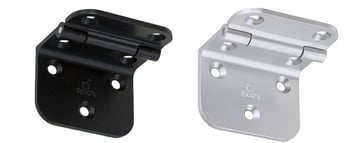[Guide] All about hinges: What, where and how
In the world of door, window and hatch hinges, there is an almost endless variety of products. Even for experts, it is sometimes not easy to decide which type of hinge is best suited for which application. As a manufacturer of high-quality fittings such as hinges, our goal is to contribute to better orientation and easier product selection.
Before you decide on a specific type of hinge, it is important to get an overview. Here is a list.
The most common types of hinges

Friction hinges
What: The friction hinge is designed to provide consistent resistance when moving the component. This means that the component remains stable at any angle. There are two types of friction hinges: hinges with constant friction and hinges with adjustable friction torque.
What for: Lids, doors and display panels to keep them at a certain angle for a long time.
When not: When a permanent and smooth movement without additional resistance is required. For example, they are unsuitable for heavy doors or flaps where the friction requires too much effort.
What: The friction hinge is designed to provide consistent resistance when moving the component. This means that the component remains stable at any angle. There are two types of friction hinges: hinges with constant friction and hinges with adjustable friction torque.
What for: Lids, doors and display panels to keep them at a certain angle for a long time.
When not: When a permanent and smooth movement without additional resistance is required. For example, they are unsuitable for heavy doors or flaps where the friction requires too much effort.
Lift-off hinges
What: Lift-off hinges are special door hinges that allow a door to be removed quickly and easily, without any tools. This hinge offers flexibility and makes handling easier. They are also suitable for furniture construction.
What for: Areas where maintenance or cleaning is required, such as machine panels or cabinets.
When not: Applications where high security or stability is required, such as heavy doors or safety-relevant areas.
What: Lift-off hinges are special door hinges that allow a door to be removed quickly and easily, without any tools. This hinge offers flexibility and makes handling easier. They are also suitable for furniture construction.
What for: Areas where maintenance or cleaning is required, such as machine panels or cabinets.
When not: Applications where high security or stability is required, such as heavy doors or safety-relevant areas.

Hatch hinges
What: Hatch hinges provide a stable attachment and allow the hatch to be opened completely without the hinge protruding beyond the edges.
What for: Hatches on boats, inspection hatches, floor hatches or cabinet hatches where a discreet design and flush closing are important.
When not: When high load-bearing capacity or load-bearing capacity is required, as they are often less robust than conventional hinges.
What: Hatch hinges provide a stable attachment and allow the hatch to be opened completely without the hinge protruding beyond the edges.
What for: Hatches on boats, inspection hatches, floor hatches or cabinet hatches where a discreet design and flush closing are important.
When not: When high load-bearing capacity or load-bearing capacity is required, as they are often less robust than conventional hinges.
Surface-mounted hinges
What: Hinges that are mounted on the surface of a piece of furniture, door or window without having to be recessed into the material.
What for: Furniture, cabinet doors and smaller structures.
When not: When a flush, unobtrusive look is desired as they are visibly mounted on the surface.
What: Hinges that are mounted on the surface of a piece of furniture, door or window without having to be recessed into the material.
What for: Furniture, cabinet doors and smaller structures.
When not: When a flush, unobtrusive look is desired as they are visibly mounted on the surface.

Piano hinges
What: Piano hinges are rectangular, narrow, they vary in length between 1000 and 2000 mm and can be cut to size if required.
What for: Piano hinges are often used for cases and boxes.
When not: They are unsuitable for heavy doors.
What: Piano hinges are rectangular, narrow, they vary in length between 1000 and 2000 mm and can be cut to size if required.
What for: Piano hinges are often used for cases and boxes.
When not: They are unsuitable for heavy doors.
Special hinges
What: Special hinges, such as folding table hinges, are manufactured with the utmost precision. Examples include hatch hinges with a removable pin or hinges for tables.
What for: They can be used in many different applications.
When not: If the application requirements can be met by conventional hinges.
What: Special hinges, such as folding table hinges, are manufactured with the utmost precision. Examples include hatch hinges with a removable pin or hinges for tables.
What for: They can be used in many different applications.
When not: If the application requirements can be met by conventional hinges.
Shower hinges
What: Hinges that allow the shower door to be opened and closed while providing stability. Shower hinges are often made of rust-proof materials such as stainless steel or chrome-plated brass.
What for: Shower door hinges are used for fastening and pivoting glass doors in shower cubicles. They can be used in damp rooms such as showers and saunas and have a load capacity of up to 50 kilograms when mounted in pairs. The hinges are compatible with glass panels with a thickness of between 8 and 13 mm. Depending on requirements and structural conditions, wall-glass installations and glass-glass installations can be implemented in different angles (from 90 degrees to 180 degrees).
When not: When bathroom space is limited or accessibility is required as they require extra space to open the door and have a threshold.
What: Hinges that allow the shower door to be opened and closed while providing stability. Shower hinges are often made of rust-proof materials such as stainless steel or chrome-plated brass.
What for: Shower door hinges are used for fastening and pivoting glass doors in shower cubicles. They can be used in damp rooms such as showers and saunas and have a load capacity of up to 50 kilograms when mounted in pairs. The hinges are compatible with glass panels with a thickness of between 8 and 13 mm. Depending on requirements and structural conditions, wall-glass installations and glass-glass installations can be implemented in different angles (from 90 degrees to 180 degrees).
When not: When bathroom space is limited or accessibility is required as they require extra space to open the door and have a threshold.

Rakego hinge
What: The Rakego Scharnier is something really special. It is made of aluminum (AA6061) and you can choose between anodized black or a natural finish. Because of its robust material, the hinge can be used not only indoors but also outdoors, even in adverse conditions.
What for: Read an example here.
When not: When a simple hinge is sufficient and that is not exposed to adverse conditions.
What: The Rakego Scharnier is something really special. It is made of aluminum (AA6061) and you can choose between anodized black or a natural finish. Because of its robust material, the hinge can be used not only indoors but also outdoors, even in adverse conditions.
What for: Read an example here.
When not: When a simple hinge is sufficient and that is not exposed to adverse conditions.
When buying hinges, you should consider the following four things:
1. The material of the door or window
For wooden doors or concrete frames, hinges that can be screwed on are suitable as they can be firmly anchored into the materials. For metal doors or frames, hinges that are welded on are a better choice as this method ensures a stronger connection for metal.
For wooden doors or concrete frames, hinges that can be screwed on are suitable as they can be firmly anchored into the materials. For metal doors or frames, hinges that are welded on are a better choice as this method ensures a stronger connection for metal.
2. Place of use
This is important if the hinges are to be used outdoors. In such cases, you should choose weatherproof materials to avoid corrosion. Stainless steel hinges (such as ROCA Industry's hinges) or stainless steel are durable and resistant to environmental influences such as humidity and temperature fluctuations.
This is important if the hinges are to be used outdoors. In such cases, you should choose weatherproof materials to avoid corrosion. Stainless steel hinges (such as ROCA Industry's hinges) or stainless steel are durable and resistant to environmental influences such as humidity and temperature fluctuations.
3. Mechanical properties
Heavy doors require correspondingly strong hinges with high load-bearing capacity. Light furniture hinges, such as those made of brass, are not suitable for heavy entrance doors. Therefore, check carefully what weight the hinge can bear to ensure long durability and safe function.
Heavy doors require correspondingly strong hinges with high load-bearing capacity. Light furniture hinges, such as those made of brass, are not suitable for heavy entrance doors. Therefore, check carefully what weight the hinge can bear to ensure long durability and safe function.
4. Installation type
Screw-on hinges are mounted directly on the door and frame and are visible, while internal furniture hinges are installed inside the door frame, ensuring a smooth, uninterrupted surface. The choice depends on the desired design.
Screw-on hinges are mounted directly on the door and frame and are visible, while internal furniture hinges are installed inside the door frame, ensuring a smooth, uninterrupted surface. The choice depends on the desired design.




